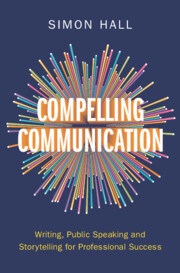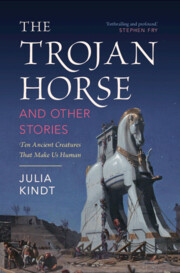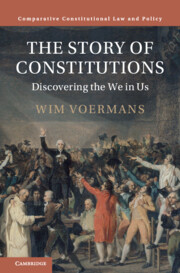84 results
11 - Composing for the Screen
- from Part II - Techniques
-
-
- Book:
- The Cambridge Companion to Composition
- Published online:
- 25 May 2024
- Print publication:
- 30 May 2024, pp 164-174
-
- Chapter
- Export citation
4 - The Splendour of Storytelling
-
- Book:
- Compelling Communication
- Published online:
- 30 May 2024
- Print publication:
- 30 May 2024, pp 93-120
-
- Chapter
- Export citation
Introduction
-
- Book:
- Compelling Communication
- Published online:
- 30 May 2024
- Print publication:
- 30 May 2024, pp 1-4
-
- Chapter
- Export citation

Compelling Communication
- Writing, Public Speaking and Storytelling for Professional Success
-
- Published online:
- 30 May 2024
- Print publication:
- 30 May 2024
A Compelling Conclusion (Hopefully)
-
- Book:
- Compelling Communication
- Published online:
- 30 May 2024
- Print publication:
- 30 May 2024, pp 319-324
-
- Chapter
- Export citation
2 - The Black Body and the Medical Archive
- from Part I - Extraction and Abstraction
-
-
- Book:
- The Cambridge Companion to the Black Body in American Literature
- Published online:
- 09 May 2024
- Print publication:
- 16 May 2024, pp 32-48
-
- Chapter
- Export citation
Research story telling: using the research journey map to communicate information, data, systems, and artifacts
-
- Journal:
- Proceedings of the Design Society / Volume 4 / May 2024
- Published online by Cambridge University Press:
- 16 May 2024, pp. 2337-2342
-
- Article
-
- You have access
- Open access
- Export citation
Populist Storytelling and Negative Affective Polarization: Social Media Evidence from Mexico
-
- Journal:
- Latin American Politics and Society , FirstView
- Published online by Cambridge University Press:
- 09 April 2024, pp. 1-30
-
- Article
-
- You have access
- Open access
- HTML
- Export citation
“The Indian Side of the Question”: Settling the Story of Potawatomi Removal in the Twentieth-Century Midwest
-
- Journal:
- The Journal of the Gilded Age and Progressive Era / Volume 23 / Issue 2 / April 2024
- Published online by Cambridge University Press:
- 17 May 2024, pp. 170-189
- Print publication:
- April 2024
-
- Article
- Export citation
6 - ‘I’ll Just Stop You There’: Fragmentation of Refugees’ Oral Testimony
-
- Book:
- Judging Refugees
- Published online:
- 15 March 2024
- Print publication:
- 28 March 2024, pp 113-135
-
- Chapter
- Export citation
Older people enacting resilience in stories about living alone and receiving home care
-
- Journal:
- Ageing & Society , First View
- Published online by Cambridge University Press:
- 17 January 2024, pp. 1-20
-
- Article
-
- You have access
- Open access
- HTML
- Export citation
13 - Orchestrating Chaos
- from Part IV - Literary Genres
-
-
- Book:
- Jazz and American Culture
- Published online:
- 09 November 2023
- Print publication:
- 30 November 2023, pp 203-218
-
- Chapter
- Export citation

The Trojan Horse and Other Stories
- Ten Ancient Creatures That Make Us Human
-
- Published online:
- 09 November 2023
- Print publication:
- 11 January 2024
27 - The Story of the Constitution
- from Part V - The Imagined Order of the Constitution
-
- Book:
- The Story of Constitutions
- Published online:
- 19 October 2023
- Print publication:
- 02 November 2023, pp 314-321
-
- Chapter
- Export citation

The Story of Constitutions
- Discovering the We in Us
-
- Published online:
- 19 October 2023
- Print publication:
- 02 November 2023
Chapter 14 - QAnon, Folklore, and Conspiratorial Consensus
- from Part IV - The Role of Communication in Promoting and Limiting QAnon Support
-
-
- Book:
- The Social Science of QAnon
- Published online:
- 14 September 2023
- Print publication:
- 28 September 2023, pp 234-251
-
- Chapter
- Export citation
17 - Telling Stories with Data
-
- Book:
- Experimental Design and Data Analysis for Biologists
- Published online:
- 04 September 2023
- Print publication:
- 07 September 2023, pp 337-364
-
- Chapter
- Export citation
(Re)criminalizing Abortion: Returning to the Political with Stories
-
- Journal:
- Journal of Law, Medicine & Ethics / Volume 51 / Issue 3 / Fall 2023
- Published online by Cambridge University Press:
- 13 December 2023, pp. 480-484
- Print publication:
- Fall 2023
-
- Article
-
- You have access
- Open access
- HTML
- Export citation
THE ROLE OF STORYTELLING AS AN ANALYTICAL TOOL IN SCIENTIFIC RESEARCH
-
- Journal:
- Proceedings of the Design Society / Volume 3 / July 2023
- Published online by Cambridge University Press:
- 19 June 2023, pp. 3483-3492
-
- Article
-
- You have access
- Open access
- Export citation
Chapter 12 - Native American Short Stories
- from Part III - People and Places
-
-
- Book:
- The Cambridge Companion to the American Short Story
- Published online:
- 11 May 2023
- Print publication:
- 25 May 2023, pp 191-205
-
- Chapter
- Export citation



